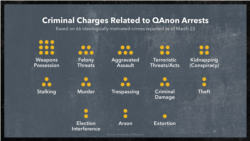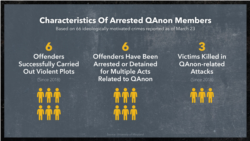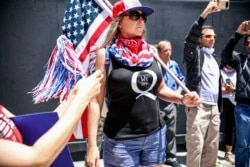Many followers of the QAnon conspiracy theory see themselves as digital warriors battling an imaginary cabal of Satan-worshipping pedophiles who rule the world from the convenience of their keyboards.
But the January 6 U.S. Capitol riot by supporters of former President Donald Trump exposed the potential for violence in a movement that reared its head on the fringes of the internet in 2018 and now boasts millions of adherents around the world.
At least 34 QAnon adherents participated in the Capitol siege that disrupted the certification of President Joe Biden’s election victory, while 32 other QAnon followers committed ideologically motivated crimes before and after the Capitol insurrection — for a total of 66 who engaged in criminal conduct.
This is according to researchers at the National Consortium for the Study of Terrorism and Responses to Terrorism (START) at the University of Maryland, who have conducted the most comprehensive study yet of QAnon’s criminal activities. The conspiracy theorists' alleged offenses ranged from weapons possession to kidnapping and murder.
The 34 followers who took part in the Capitol riot represent more than 8% of the roughly 400 rioters who have been arrested to date; that shows a greater QAnon presence in the riot than had been previously estimated. The number is likely to increase as the FBI continues to investigate the Capitol riot, said Michael Jensen, a senior researcher at START.
In the latest case not included in the START report, a Texas-based lifestyle coach and her QAnon-following boyfriend were arrested last week on charges of storming the Capitol, according to a criminal complaint unsealed on Tuesday.
While the vast majority of QAnon believers don't advocate violence, the report shows the movement's potential for violence, an assessment first made by the FBI in 2019.
"Not all the violent extremists are jihadists or white supremacists, they come from these conspiracy theory groups as well," Jensen said in an interview.
Among the most notorious QAnon supporters arrested in the Capitol riot was Jacob Chansley, a 33-year-old Arizona man known as "QAnon Shaman." Sporting horns, a bearskin headdress, and red, white and blue face paint, he entered the Senate chamber where he left a threatening note for then Vice President Mike Pence that read, "It's Only a Matter of Time. Justice is Coming,” according to court documents.
The QAnon movement took off in late 2017 when an anonymous prognosticator began posting on the 4chan imageboard about an alleged plot by Satan-worshipping pedophiles and global elites seeking to undermine Trump. Though Q's predictions have failed to materialize, the conspiracy has lived on.
The first known QAnon-inspired criminal act occurred in June 2018 when QAnon follower Matthew Wright had a standoff with law enforcement officers in the middle of a bridge in Arizona, according to Travis View, co-host of the QAnon Anonymous Podcast.
Wright demanded the release of a Justice Department inspector general report on the Russia investigation that he believed would "reveal all of the things that the deep state was supposedly doing," View said.
"He was certainly motivated by QAnon ideology," View said.
The following year, Anthony Comello killed suspected Gambino crime family boss Francesco Cali outside the victim’s home, believing Cali was part of the deep state — the suspected invisible, sinister power structure — according to View. It was one of three homicides linked to QAnon since 2018.
"A lot of QAnon followers have this sense of moral righteousness that they are fighting a very noble crusade and this allows them to [use it] as moral justification to do some very dangerous and criminal things, which is the case with all extremists," View said.
The START report on QAnon offenders is part of an ongoing study of radicalization in the United States. It comes amid heightened concern in the U.S. about domestic violent extremism in the wake of the Capitol riot.
Reflecting the makeup of the broader QAnon stratosphere, the QAnon offenders studied by START are a diverse group.
“Some come from affluent backgrounds, with good educations and work experience, and have no known criminal histories,” Jensen said. “Others were unemployed at the time of their arrests, come from poor socio-economic backgrounds, and have substance abuse or mental health issues.”
However, several characteristics set them apart from other far-right extremists. For one, the QAnon adherents in the study tended to be an older group, averaging 42 in age. There were also far more women in their ranks; 16 of the 66 QAnon adherents facing charges are women. Among the 35 arrested before the Capitol riot, 63% had documented mental illness while 44% radicalized after experiencing trauma. Three of those people took part in the riot and were arrested again.
"There are a number of [women] whose children have been victims of physical or sexual abuse by family members [or] their children had been taken away from them," Jensen said. "That really sparked their kind of radicalization process into the movement, that they were drawn to the narrative that QAnon is fighting this ring of criminals that are engaging in child sex trafficking."
There were notable differences between the QAnon followers who took part in the riot and those who were arrested earlier. The most glaring was that those who took part in the riot had lower rates of substance abuse, mental illness, and unemployment. The non-QAnon rioters also had a generally low rate of unemployment, suggesting that the pro-Trump mob was a relatively well-off group with the means to take time off and travel to Washington.
Twelve of the 66 had known ties to other extremist groups, suggesting cross-pollination across extremist lines.
Seven belonged to the so-called "sovereign citizens" anti-government movement, two each were members of the Oath Keepers and the Proud Boys, and one was affiliated with the Wolverine Watchmen militia. But only two of the 12 — Oath Keepers Joshua Macias and Antonio Lamotta — participated in the Capitol riot.
In most cases, Jensen said, the QAnon followers with “dual affiliations” had already been immersed in other movements before embracing the conspiracy theory.
Colin Clarke, director of policy and research at the Soufan Group, said far-right groups see QAnon conspiracy theorists as "useful fools."
"We've seen on the Telegram channels online discussions from other aspects of the far-right, openly talking about whether or not and how to recruit these people now that these conspiracies have proven bankrupt," Clarke said.
What connects the two movements, Clarke said, is "a heavy dose of anti-Semitism" that permeates the conspiracy theory.







